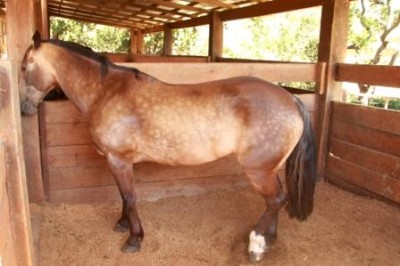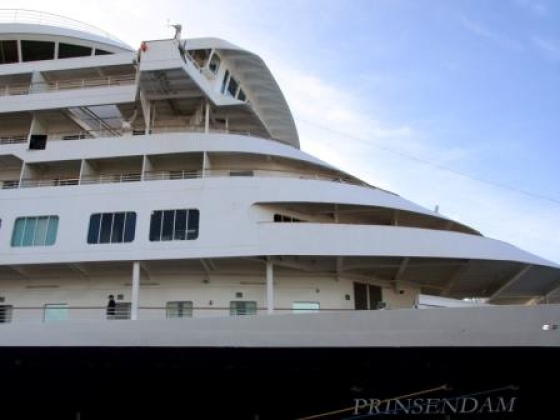We arrived in Valparaiso at noon. “Paradise Valley” must have thought that it had to dress up for Carnival. The latter being so late in the year, it was a forgivable faux pas. Rather than at its colorful best, it seemed to be in a greyish mourning costume, as befits Good Friday, perhaps. This Valparaiso was a totally uninspiring sight, so that the many passengers that were not ready for the festive sail-in, weren’t really missing much.
For starters then, the short hop – still twenty hours, from Robinson Crusoe Island straight East to the mainland, pushed our second night in Antarctica out of the top spot in the hit chart of “worst seas”. It was a truly rocking affair, driven by the big swell from the West and supported by a cold, hard wind from the South. The latter meant that I could not open my door either. At four in the morning I woke up, sweating and with my stomach not in high spirits. After a really quick breath of fresh air, a little stomach pill and the intent to keep my seasickness record perfect, I went to sleep again. I do not remember any sweat dreams, but my record survived. From here on in, as we approach the tropics, this record should be safe all the way to Ft. Lauderdale.
Obviously, the sail-in at Valparaiso was nothing to write home about: grey, cool and, if you also consider the industrial port, not very inviting. I had no plans to visit the city (with 350K inhabitants, the second biggest in Chile), but I had opted for rodeo and wine in the countryside, topped off with some culture in the Viña del Mar, adjacent to Valparaiso but “chique”.
Just after noon we were heading for the Casablanca Valley, almost half way to Santiago. To be sure, there is not much charm in the surroundings. It resembles perhaps the San Fernando Valley in California, or the Corbières region in France. Our host turned out to be a big agricultural hacienda (I believe it is called “fundado” in Chile). Apart from vegetables and fruit, they were also into horses, Chilean horses. They resemble the Islanders in many respects, but, being a cross between Arabian and Castilian breeds, they are much more graciously built. If the Islander is a peasant, the Chilean is a nobleman.
The animals are purely bred for human pleasure, the biggest one being the national sport in Chile: rodeo. The “guaso” is to Chile what the more renowned “gaucho” is to Argentina, with the interesting detail that a guaso does not eat together with his horse, but normal foodstuffs instead. That doesn’t impair their phenomenal riding skills and equestrian prowess. I have not yet seen a sideways gallop at the same speed, developed within a short distance and closed out by a lightning stop, as I have enjoyed here.
 A girl of thirteen then, emphasizing how many lives revolve around horses, crawled between her horse’s front legs and hind legs, closing out her demonstration of trust between human and animal by inducting the horse to lay down, while she was sitting in the saddle. Quite a feat, I am told by people that know more about horses than I do. Rodeo is not only horses; it is also women, sorry – dancing. The Chilean “cueca” (national dance) is based on the rooster seducing the chicken. The only comment that I can make about it is that Belgian roosters do not waste all the time that Chilean roosters do, at least of the dance is a reliable rendition of the rooster’s behavior.
A girl of thirteen then, emphasizing how many lives revolve around horses, crawled between her horse’s front legs and hind legs, closing out her demonstration of trust between human and animal by inducting the horse to lay down, while she was sitting in the saddle. Quite a feat, I am told by people that know more about horses than I do. Rodeo is not only horses; it is also women, sorry – dancing. The Chilean “cueca” (national dance) is based on the rooster seducing the chicken. The only comment that I can make about it is that Belgian roosters do not waste all the time that Chilean roosters do, at least of the dance is a reliable rendition of the rooster’s behavior.
The Casablanca valley is also known for its wines. “To be known for” is always a relative qualification; I knew quite a few viticulture valleys in Chile, but Casablanca meant only White House or Humphrey Bogarts to me! Nevertheless, the domain looked attractive with, coincidence perhaps, a cozy “casa blanca” to boost. At the very least our tour of the facilities showed that investment (here by Italians) is continuing and the wine-making infrastructure can compete with the best and most modern in Europe. Whether the oenologists can, is a different matter altogether.
We tried three wines: Sauvignon Blanc, Chardonnay and Syrah. The vineyards at this (relatively) northerly location are better suited for whites than for reds because the climate is not really warm enough. While all the wines that we tasted were well-made, limpid and brilliant, I am disappointed by the pure “varietal” wines that are being produced. While the Sauvignon was acidic, with some notes of green grapefruit, the Syrah had lots of blackberry fruit but little structure. Both of these, and I am as much an oenologist as a horseman, would benefit, in my minds, by a few supporting grapes.
Then again, the wine industry, certainly in the New World is first business, before quality enters in the equation. Yesterday I took part in a Chilean wine tasting on the ship and was astounded by the baseless prejudice of the primarily American consumer, about single grapes as well as about price appreciation. It is obvious that a new winery cannot sell its product outside of the “single varietal” framework for the simple reason that the biggest markets will only buy varietals. They are often unaware of the fact that other products even exist.
Surely, Chateau Lafite and Mouton Rotschild can do as they please but Domain Casas del Bosque has no chance to establish its brand, no matter how great a sophisticated wine they would produce. In the end these wineries are condemned to compete on price and by varietal. Let me add that “Casas del Bosque” from Casablanca Valley makes very drinkable wine at the best prices that I have seen, since leaving Europe. Let me also add that I am utterly surprised at the margins that big distributors take on these wines in the States as well as in Europe.
I have added this digression because I am sure that many readers want to learn my (learned?) opinion about this matter. To cover all bases: compared to Brazilian, Uruguayan and Argentinean wines, the Chilean product is definitely superior in quality and in price! It would have been great to end the day here, but there was still a detour via Viña del Mar and the museum.
To make a long story short, Viña del Mar was celebrating the first day of their annual 5-day Music Festival and traffic as a mess. And, as befits such events, at every highest class hotel (a category of which the city sports quite a few) there was throngs of excited youths awaiting the appearance of their idols. By the time we arrived at the Fonck Museum, to be imbibed with Easter Island culture, I chose for fresh air instead …
Before returning to the ship, late in the evening, I still wanted to make arrangements for a journey to admire the Acongagua, the next day. That proved more difficult than I anticipated for two reasons. First, the mountain itself was not 100 miles (160km) away, as I had thought, but 150 miles (240km). That meant a three to four hour drive, all the way to Portillo on the Argentine border. The second reason was that there were few, if any, viewing spots at intermediate places; moreover the weather forecast was unfavorable, as well. After forty-five minutes of calling and investigating and weighing options, the advice was that I should consider foregoing the trip, unless … unless the weather forecast would be wrong.
Unfortunately it wasn’t. In the morning low clouds hung over Valparaiso. I checked the website of the Chilean Meteo and they predicted rain and clouds. Acongagua will not run away of course, and I will have to come back to see it! As we left Valparaiso at 1800 hours, I was able to shoot my first “sunny picture” in this – they say – charming city!
 Prinsendam, Day 53 – Saturday Feb 26th, 2011
Prinsendam, Day 53 – Saturday Feb 26th, 2011
Ready for some desert! (i.e. a non-fattening, very dry place)
P.S. At the wine tasting on the ship, I found myself seated next to a lady from Pine Mountain, Halloway Gardens, Georgia. Many ISSers have visited or stayed at these (usually) lovely gardens more than once. What a small world!

